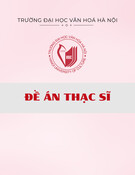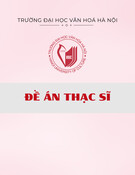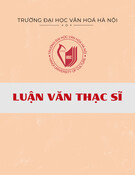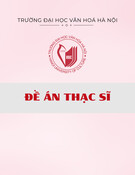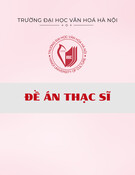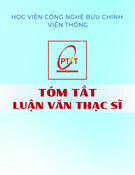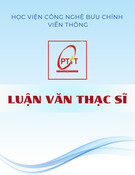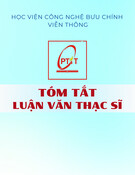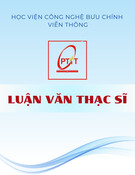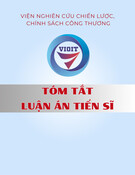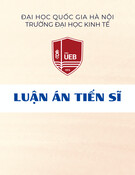
Annals of Mathematics
On fusion categories
By Pavel Etingof, Dmitri Nikshych, and Viktor
Ostrik

Annals of Mathematics,162 (2005), 581–642
On fusion categories
By Pavel Etingof, Dmitri Nikshych, and Viktor Ostrik
Abstract
Using a variety of methods developed in the literature (in particular, the
theory of weak Hopf algebras), we prove a number of general results about
fusion categories in characteristic zero. We show that the global dimension of
a fusion category is always positive, and that the S-matrix of any (not nec-
essarily hermitian) modular category is unitary. We also show that the cate-
gory of module functors between two module categories over a fusion category
is semisimple, and that fusion categories and tensor functors between them
are undeformable (generalized Ocneanu rigidity). In particular the number of
such categories (functors) realizing a given fusion datum is finite. Finally, we
develop the theory of Frobenius-Perron dimensions in an arbitrary fusion cat-
egory. At the end of the paper we generalize some of these results to positive
characteristic.
1. Introduction
Throughout this paper (except for §9), kdenotes an algebraically closed
field of characteristic zero. By a fusion category Cover kwe mean a k-linear
semisimple rigid tensor (=monoidal) category with finitely many simple ob-
jects and finite dimensional spaces of morphisms, such that the endomorphism
algebra of the neutral object is k(see [BaKi]). Fusion categories arise in several
areas of mathematics and physics – conformal field theory, operator algebras,
representation theory of quantum groups, and others.
This paper is devoted to the study of general properties of fusion cate-
gories. This has been an area of intensive research for a number of years, and
many remarkable results have been obtained. However, many of these results
were proved not in general but under various assumptions on the category.
The goal of this paper is to remove such assumptions, and to give an account
of the theory of fusion categories in full generality.
The structure of the paper is as follows.
In Section 2, we give our main results about squared norms, global dimen-
sions, weak Hopf algebras, and Ocneanu rigidity. This section contains many

582 PAVEL ETINGOF, DMITRI NIKSHYCH, AND VIKTOR OSTRIK
results which are partially or fully due to other authors, and our own results
are blended in at appropriate places.
Sections 3-7 are mostly devoted to review of the technical tools and to
proofs of the results of Section 2. Namely, in Section 3, we prove one of the
main theorems of this paper, saying that any fusion category has a nonzero
global dimension (in fact, we show that for k=C, the dimension is positive).
The proof relies in an essential way on the theorem that in any fusion category,
the identity functor is isomorphic to ∗∗∗∗:V→ V∗∗∗∗ (where V→ V∗is
the duality in C), as a tensor functor, which is proved using the theory of
weak Hopf algebras (more specifically, the formula for the fourth power of the
antipode from [N]). We also prove that the SL2(Z)-representation attached to
any modular category over Cis unitary.
In Section 4, we give a short review of the theory of weak Hopf algebras,
which are both a tool and an object of study in this paper, and prove the
isomorphism between the identity functor Id and ∗∗∗∗, which is crucial for
the main theorem.
In Section 5, we prove a formula for the trace of squared antipode of a
semisimple connected regular weak Hopf algebra. Then we proceed to prove
a number of results (partially due to M¨uger) about semisimplicity of the cat-
egory of module functors between module categories over a fusion category,
in particular of the dual and the Drinfeld center. We also generalize these
results to multi-fusion categories (the notion obtained from that of a fusion
category by relaxing the condition that End(1)=k). In particular, we prove
that a semisimple weak Hopf algebra over kis cosemisimple. Finally, we prove
a categorical version of the class equation of Kac and Zhu.
In Section 6, we consider a pair of semisimple weak Hopf algebras B⊂A
and study the subcomplex of B-invariants in the co-Hochschild complex of A
(this complex is a weak analog of the complex considered in [Sch], [EG1] for
Hopf algebras). We prove that this complex is acyclic in positive degrees.
In Section 7, we show that the complex considered in Section 6 coin-
cides with the deformation complex of a monodial functor between two multi-
fusion categories introduced independently by Yetter [Y1, Y2] and Davydov
[Da]. Using this, we establish “Ocneanu rigidity” (absence of deformations) for
arbitrary nondegenerate multi-fusion categories and tensor functors between
them. The idea of the proof of this result is due to Ocneanu-Blanchard-
Wassermann, and the fusion category case was worked out completely by
Blanchard-Wassermann in [Wa], [BWa] under the assumption that the global
dimension is nonzero.
In Section 8 we discuss the notion of Frobenius-Perron dimensions of ob-
jects in a fusion category, show that they are additive and multiplicative, and
have similar properties to categorical dimensions in a pivotal category. We
prove a categorical analogue of the Nichols-Zoeller freeness theorem (saying

ON FUSION CATEGORIES 583
that a finite dimensional Hopf algebra is a free module over a Hopf subalgebra),
in particular prove the freeness theorem for semisimple quasi-Hopf algebras.
We also show that the global dimension of a fusion category is divisible by its
Frobenius-Perron dimension (in the ring of algebraic integers), and the ratio
is ≤1. In particular, if the Frobenius-Perron dimension of a fusion category
is an integer, then it coincides with the global dimension. This result may
be regarded as a categorical version of the well-known theorem of Larson and
Radford, saying that the antipode of a semisimple Hopf algebra is involutive.
Further, we show that the Frobenius-Perron dimension of a fusion category
is divisible by the Frobenius-Perron dimension of its full subcategory, and use
this result to show that any fusion category of Frobenius-Perron dimension p(a
prime) is the category of representations of a cyclic group with a 3-cocycle. We
also classify fusion categories of dimension p2. Finally, we show that the prop-
erty of a fusion category to have integer Frobenius-Perron dimensions (which
is equivalent to being the representation category of a quasi-Hopf algebra) is
stable under basic operations with categories, in particular is “weak Morita in-
variant” (i.e. invariant under passing to the the opposite of the dual category).
At the end of the section we define group-theoretical fusion categories, which is
a subclass of fusion categories with integer Frobenius-Perron dimensions; they
are constructed explicitly from finite groups.
Many of the results of this paper have analogs in positive characteristic.
These generalizations are given in Section 9. In particular, we show that a fu-
sion category of nonzero global dimension over a field of positive characteristic
can be lifted to characteristic zero.
Throughout the paper, we are going to freely use the theory of rigid tensor
categories. We refer the reader to the textbooks [K], [BaKi] for details. We also
recommend the reader the expository paper [CE], where much of the content
of this paper is discussed in detail.
Acknowledgments. The research of P.E. was partially supported by the
NSF grant DMS-9988796, and was done in part for the Clay Mathematics
Institute. The research of D.N. was supported by the NSF grant DMS-0200202.
The research of V.O. was supported by the NSF grant DMS-0098830. We are
grateful to A. Davydov, A. Kirillov Jr., M. M¨uger, and A. Wassermann for
useful discussions, and to E. Blanchard for giving us the formulation of the
result of [BWa] before publication.
2. Results on squared norms, global dimensions, weak Hopf
algebras, and Ocneanu rigidity
Let kbe an algebraically closed field. By a multi-fusion category over kwe
mean a rigid semisimple k-linear tensor category Cwith finitely many simple
objects and finite dimensional spaces of morphisms. If the unit object 1of C

584 PAVEL ETINGOF, DMITRI NIKSHYCH, AND VIKTOR OSTRIK
is simple, then the category Cis said to be a fusion category. Otherwise (if 1
is not simple), it is easy to see that we have 1=⊕i∈J1i, where 1iare pairwise
nonisomorphic simple objects.
Let us list a few examples to keep in mind when thinking about fusion
and multi-fusion categories.
Examples of fusion categories. 1. The category VecGof finite dimensional
vector spaces graded by a finite group G(or, equivalently, finite dimensional
modules over the function algebra Fun(G, k).) Simple objects in this category
are evaluation modules Vg,g∈G, and the tensor product is given by Vg⊗Vh=
Vgh, with the associativity morphism being the identity.
More generally, pick a 3-cocycle ω∈Z3(G, k×). To this cocycle we can
attach a twisted version VecG,ω of VecG: the simple objects and the tensor
product functor are the same, but the associativity isomorphism is given by
ΦVg,Vh,Vk=ω(g, h, k)id. The pentagon axiom then follows from the cocycle
condition
ω(h, k, l)ω(g, hk, l)ω(g, h, k)=ω(gh,k,l)ω(g, h, kl).
Note that cohomologous cocycles define equivalent fusion categories.
2. The category of finite dimensional k-representations of a finite group G,
whose order is relatively prime to the characteristic of k.
3. The category of integrable modules (from category O) over the affine
algebra
sl2at level l(see [BaKi]). The tensor product in this category is the
fusion product, defined at the level of objects by the Verlinde fusion rule
Vi⊗Vj=
l−|i+j−l|
k=|i−j|
k≡i+jmod 2
Vk.
Examples of multi-fusion categories. 1. The category of finite dimensional
bimodules over a finite dimensional semisimple k-algebra, with bimodule tensor
product. It has simple objects Mij with “matrix” tensor product Mij ⊗Mjk =
Mik; thus the identity object is 1=⊕iMii.
2. The category of finite dimensional modules over the function algebra
on a finite groupoid.
2.1. Squared norms and global dimensions. Let us introduce the notion of
the global dimension of a fusion category. First of all, we have the following
known result (see e.g., [O1]).
Proposition 2.1. In a fusion category,any simple object Vis isomor-
phic to its double dual V∗∗.


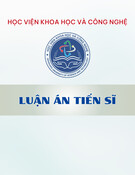
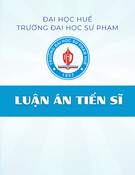
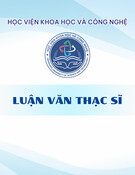
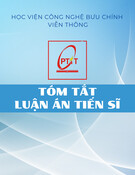
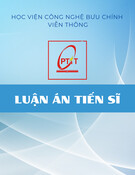
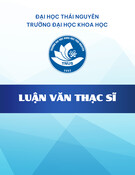
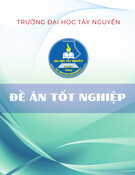
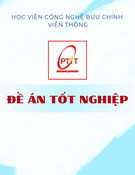

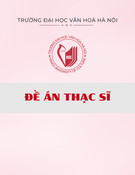


![Đề án Thạc sĩ: Tổ chức hoạt động văn hóa cho sinh viên Trường Cao đẳng Du lịch Hà Nội [Chuẩn nhất]](https://cdn.tailieu.vn/images/document/thumbnail/2025/20251202/kimphuong1001/135x160/91661764646353.jpg)
